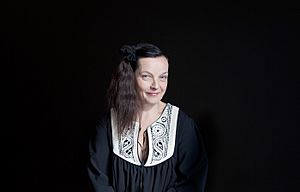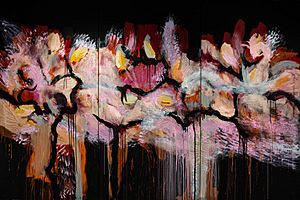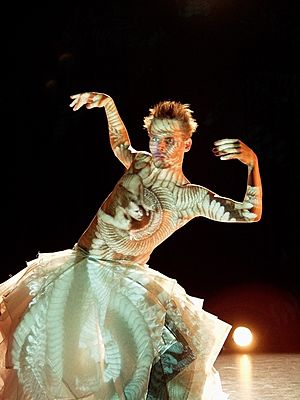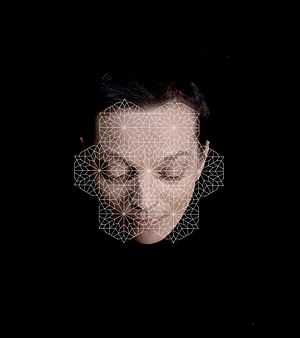Marita Liulia facts for kids
Quick facts for kids
Marita Liulia
|
|
|---|---|

Portrait of Marita Liulia by Jari Kolehmainen, 2015.
|
|
| Born | 27 October 1957 Perho, Finland
|
Marita Liulia (born October 27, 1957) is a famous visual artist from Finland. She is known for creating art using computers and technology, called interactive multimedia. This means people can often interact with her art, not just look at it.
Her CD-ROM art piece, Maire (1994), was one of the first of its kind in the world. Liulia creates many types of art, including photos, paintings, short films, and even stage shows. Her work has been shown in 50 countries, and she has won many awards.
Liulia first became interested in art while in high school. She studied art, music, photography, and painting. Later, she went to the University of Art and Design Helsinki. She also studied subjects like literature and history at the University of Helsinki.
Today, Liulia lives and works in Helsinki and Heinola, Finland. She runs her own company, Medeia Ltd., which shares her art with the world.
Contents
Artistic Career
Marita Liulia began her career in the theater. In the 1980s, she explored many different kinds of art. She created large art pieces called installation art, which often filled entire rooms. Some of these were Bone and Wing (1985) and Mummies (1988).
During this time, she also traveled a lot. She worked as a photographer and journalist in Southeast Asia and North Africa. Liulia has said that she loves Asian culture. A long illness in her childhood kept her at home, so now she enjoys traveling and exploring the world.
Moving to Multimedia
In the late 1980s, Liulia became interested in using new technology for her art. She realized that computers could help her bring her ideas to life.
She explained, "I had to start to work with computers." She saw the computer screen as a "small theatre where all magic can happen." Liulia enjoys working with a team of experts to create her large multimedia projects.
Liulia's art often explores what it's like to be a person in the modern world. She uses different types of media to reach many kinds of audiences. She sees herself as a writer, an artist, a researcher, and a producer. For her, art is a way to communicate with people.
Working with Others
In 2001, Liulia started working in theater again. She teamed up with musician Kimmo Pohjonen to create the shows Manipulator and Animator.
One of her most famous collaborations is HUNT. It is a dance performance she created with dancer Tero Saarinen. The show is a modern version of the famous ballet The Rite of Spring. HUNT has been performed over 170 times in 32 countries. Critics have praised it for being powerful and creative. In the show, animated images created by Liulia are projected onto the dancer's body.
Notable Artworks
Marita Liulia has created many important and interesting artworks throughout her career.
Early Works
- Self-portraits 1980-90, from Schjerfbeck to Video Grate, 1990
- Jackpot, 1991: An interactive art piece about the world of advertising. Liulia was inspired by a popular game called Jackpot. She wanted to see if people could tell the difference between art and ads.
Interactive CD-ROMs
Maire (1994)
This interactive CD-ROM explores an important art movement in Finland called modernism. Liulia's goal was to "combine art, technology and science." The artwork looks at how modernism grew from the 1930s to today. It also tells the story of Maire Gullichsen, a key figure in Finnish art.
Ambitious B... (1996)
This was Liulia's international breakthrough. The interactive CD-ROM explored different ideas about being a woman in the modern world. Liulia described the main character as a "contemporary Western woman: well-educated, witty, understanding but demanding." The artwork uses quotes from famous women like Madonna and Vivienne Westwood.
This work also brought up questions about feminism in her art. Feminism is the belief that men and women should have equal rights and opportunities. Liulia has said she supports equality, even in the world of technology and art.
Son of a B... (SOB) (1999)
This was Liulia's first fictional story, also on an interactive CD-ROM. After focusing on women's experiences, she wanted to explore ideas about men. The main character is a psychoanalyst named Jacques L. Froid. Liulia spent three years researching men's studies for this project. She wanted to understand how men's roles in society were changing.
Marita Liulia Tarot (2003)
Liulia created her own version of Tarot cards, a traditional card game used for reflection. The project includes 78 unique artworks, a deck of cards, a book, and a website. It has been translated into ten languages.
Liulia first got a deck of Tarot cards in 1981. She became interested in their history and meaning. Her Tarot has been shown in museums all over the world, from Japan to Spain. She says people are interested in Tarot because "People are interested in themselves." She sees the cards as a "thinking tool" to help understand life's problems.
Choosing My Religion (2009)
This project looks at nine major world religions. Liulia explores them from a female point of view. The religions include Christianity, Judaism, Islam, Hinduism, and Buddhism.
In her photos, the artist places herself in roles usually held by men. The exhibition has two parts. One part focuses on the powerful feelings religions can create. The other part explains the main ideas of each religion. The project includes about 80 photos, 15 paintings, and several media installations.
List of Collaborations
Liulia has worked with many other talented artists.
- Manipulator (2001) and Animator (2004) with musician Kimmo Pohjonen.
- HUNT (2002) with dancer Tero Saarinen.
- Time Perspective (2008) with singer Valérie Gabail and musician Mikko Perkola.
- The Accordion Man (2009), an animated film with Kimmo Pohjonen.
- Return of the Goddess (2012), a short film with dancer Virpi Pahkinen.
- Swan Song (2014), a dance show with dancers Minna Tervamäki and Ima Iduozee.




